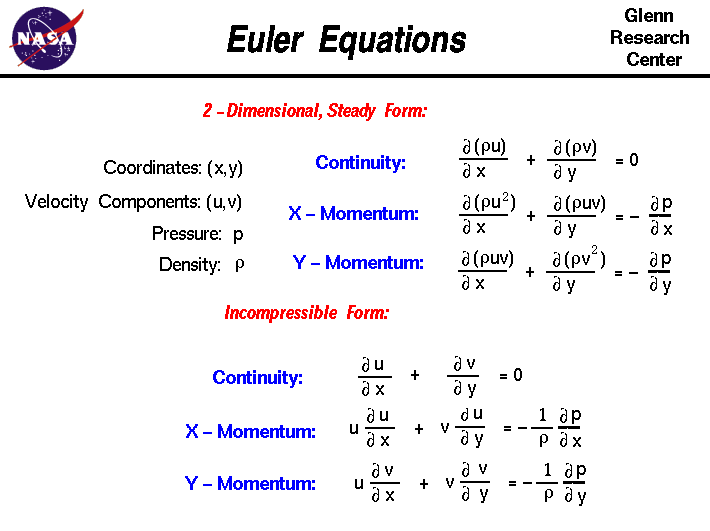
On this slide we have two versions of the Euler Equations
which describe how the velocity,
pressure
and
density
of a moving fluid are related.
The equations are named in honor of Leonard Euler, who was a student with
Daniel Bernoulli,
and studied various fluid dynamics problems
in the mid-1700's.
The equations are a set of coupled differential equations
and they can be solved for a given flow problem by using methods
from calculus.
Though the equations appear to be very complex, they are actually
simplifications of the more general
Navier-Stokes
equations of fluid dynamics. The Euler equations neglect the
effects of the
viscosity
of the fluid which are included in the Navier-Stokes equations.
A solution of the Euler equations is therefore only
an approximation to a real fluids problem.
For some problems, like the
lift
of a thin airfoil at low angle of attack, a solution of the Euler equations
provides a good model of reality. For other problems,
like the growth of the
boundary layer
on a flat plate, the Euler equations do not properly model the problem.
Our world has three spatial dimensions (up-down, left-right, fore-aft) and
one time dimension. In general, the Euler equations have a time-dependent
continuity equation for conservation of mass and three time-dependent
conservation of momentum equations.
At the top of the figure, we show a simplified, two-dimensional,
steady form of the Euler equations.
There are two independent variables in the problem, the
x and y coordinates of some domain. There are four dependent
variables, the pressure p, density r, and two
components
of the velocity
vector; the u component is in the x
direction, and the v component is in the y direction.
All of the dependent variables are
functions of both x and y.
The differential equations are therefore partial differential equations
and not ordinary differential equations that you study in a
beginning calculus class.
You will notice that the differential symbol is different than the usual
"d /dt" or "d /dx" that you see for ordinary differential equations. The symbol
" " is
used to denote partial differentiation.
The symbol indicates that we are to hold all of the
independent variables fixed, except the variable next to symbol, when computing
a derivative. The set of equations are: " is
used to denote partial differentiation.
The symbol indicates that we are to hold all of the
independent variables fixed, except the variable next to symbol, when computing
a derivative. The set of equations are:
Continuity:  (r * u)/ (r * u)/ x + x +  (r * v)/ (r * v)/ y = 0 y = 0
X - Momentum:  (r * u^2)/ (r * u^2)/ x + x +  (r * u * v)/ (r * u * v)/ y = - y = -  p/ p/ x x
Y - Momentum:  (r * u * v)/ (r * u * v)/ x + x +  (r * v^2)/ (r * v^2)/ y = - y = -  p/ p/ y y
Although these equations appear very complex, undergraduate engineering students
are taught how to derive them in a process very similar to the
derivation that we present on the
conservation of momentum
web page. The two momentum equations are two-dimensional generalizations of the
conservation of momentum equation. The
mass flow rate
equation developed on the
conservation of mass
web page is a one dimensional solution of the continuity equation shown here.
Generalized solutions of these equations are difficult to obtain.
Notice that all of the dependent variables appear in each equation.
To solve a flow
problem, you have to solve all three equations simultaneously; that is
why we call this a coupled system of equations. There is actually another
equation that is required to solve this system, since we only show three equations
for four unknowns. An
equation of state
relates the pressure and the density of a gas.
In the past, engineers made further approximations and simplifications
to the equation set until they had a group of equations that they could solve.
Recently, high speed computers have been used to solve approximations
to the equations using a variety of techniques like finite difference, finite
volume, finite element, and spectral methods.
This area of study is called Computational Fluid Dynamics or CFD.
One of the simplification methods used in the past was to assume that the
gas was very low speed and to neglect the effects of
compressibility.
In an incompressible flow, the density is constant and we can remove it from
the continuity equation:
Continuity:  u/ u/ x + x +  v/ v/ y = 0 y = 0
We can then factor the momentum equations and use the continuity equation to
simplify them:
X - Momentum: u *  u/ u/ x + v * x + v *  u/ u/ y = - [ y = - [ p/ p/ x] / r x] / r
Y - Momentum: u *  v/ v/ x + v * x + v *  v/ v/ y = - [ y = - [ p/ p/ y] / r y] / r
This set of equations was used to develop the algorithm used in the
FoilSim
computer program.
Activities:
Guided Tours
Navigation ..



- Beginner's Guide Home Page
|
